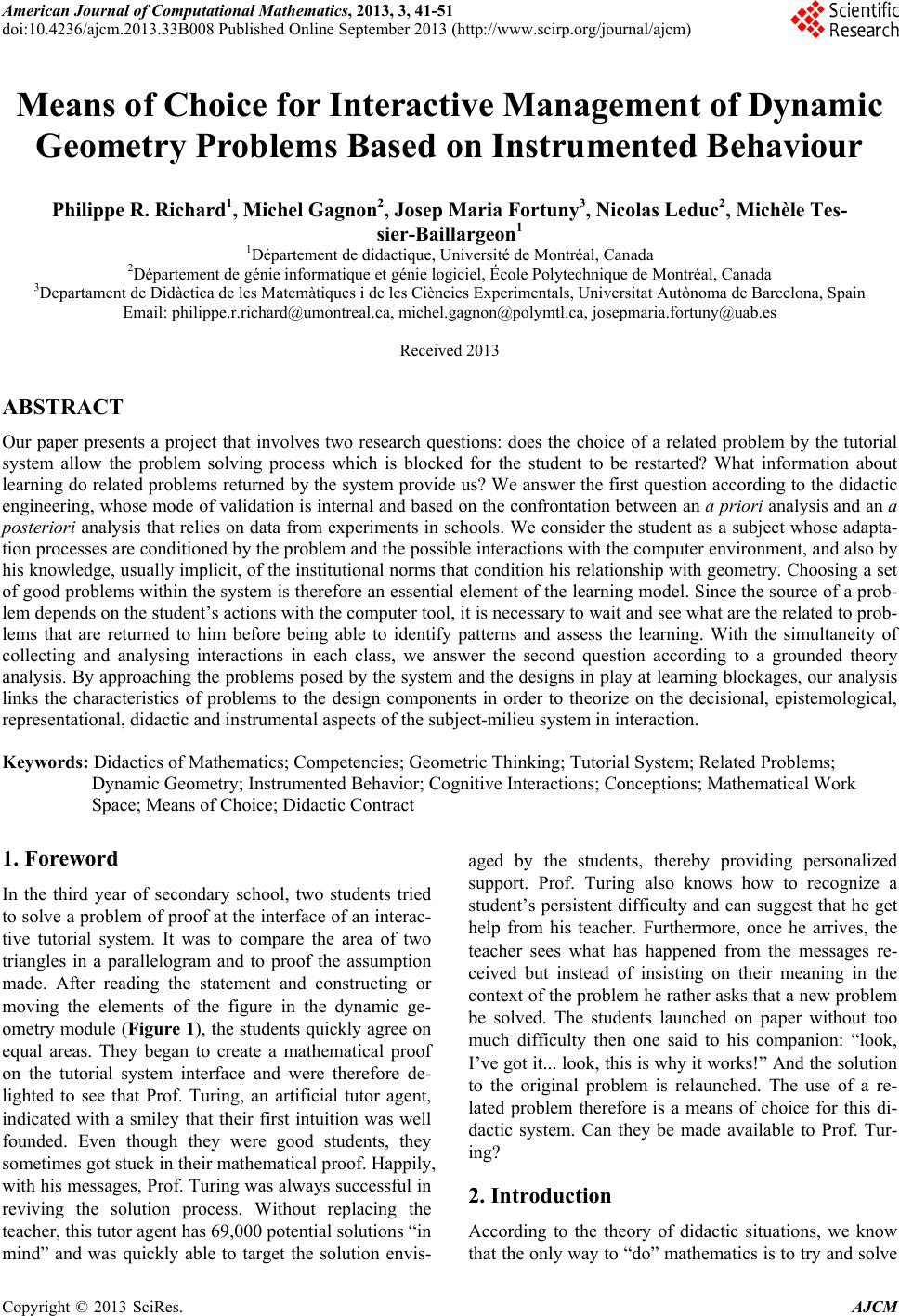 American Journal of Computational Mathematics, 2013, 3, 41-51 doi:10.4236/ajcm.2013.33B008 Published Online September 2013 (http://www.scirp.org/journal/ajcm) 1 Means of Choice for Interactive Management of Dynamic Geometry Problems Based on Instrumented Behaviour Philippe R. Richard1, Michel Gagnon2, Josep Maria Fortuny3, Nicolas Le duc2, Michèle Tes- sier-Baillargeon1 1Département de didactique, Université de Montréal, Canada 2Département de génie informatique et génie logiciel, École Polytechnique de Montréal, Canada 3Departament de Didàctica de les Matemàtiques i de les Ciències Experimentals, Universitat Autònoma de Barcelona, Spain Email: philippe.r.richard@umontreal.ca, michel.gagnon@polymtl.ca, josepmaria.fortuny@uab.es Received 2013 ABSTRACT Our paper presents a project that involves two research questions: does the choice of a related problem by the tutorial system allow the problem solving process which is blocked for the student to be restarted? What information about learning do related problems returned by the system provide us? We answer the first question according to the didactic engineering, whose mode of validation is internal and based on the confrontation between an a priori analysis and an a posteriori analysis that relies on data from experiments in schools. We consider the student as a subject whose adapta- tion processes are conditioned by the problem and the possible interactions with the computer environment, and also by his knowledge, usually implicit, of the institutional norms that condition his relationship with geometry. Choosing a set of good problems within the system is therefore an essential element of the learning model. Since the source of a prob- lem depends on the student’s actions with the computer tool, it is necessary to wait and see what are the related to prob- lems that are returned to him before being able to identify patterns and assess the learning. With the simultaneity of collecting and analysing interactions in each class, we answer the second question according to a grounded theory analysis. By approaching the problems posed by the system and the designs in play at learning blockages, our analysis links the characteristics of problems to the design components in order to theorize on the decisional, epistemological, representational, didactic and instrumental aspects of the subject-milieu system in interaction. Keywords: Didactics of Mathematics; Competencies; Geometric Thinking; Tutorial System; Related Problems; Dynamic Geometry; Instrumented Behavior; Cognitive Interactions; Conceptions; Mathematical Work Space; Means of Choice; Didactic Contract 1. Foreword In the third year of secondary school, two students tried to solve a problem of proof at the interface of an interac- tive tutorial system. It was to compare the area of two triangles in a parallelogram and to proof the assumption made. After reading the statement and constructing or moving the elements of the figure in the dynamic ge- ometry module (Figure 1), the students quickly agree on equal areas. They began to create a mathematical proof on the tutorial system interface and were therefore de- lighted to see that Prof. Turing, an artificial tutor agent, indicated with a smiley that their first intuition was well founded. Even though they were good students, they sometimes got stuck in their mathematical proof. Happily, with his messages, Prof. Turing was always successful in reviving the solution process. Without replacing the teacher, this tutor agent has 69,000 potential solutions “in mind” and was quickly able to target the solution envis- aged by the students, thereby providing personalized support. Prof. Turing also knows how to recognize a student’s persistent difficulty and can suggest that he get help from his teacher. Furthermore, once he arrives, the teacher sees what has happened from the messages re- ceived but instead of insisting on their meaning in the context of the problem he rather asks that a new problem be solved. The students launched on paper without too much difficulty then one said to his companion: “look, I’ve got it... look, this is why it works!” And the solution to the original problem is relaunched. The use of a re- lated problem therefore is a means of choice for this di- dactic system. Can they be made available to Prof. Tur- ing? 2. Introduction According to the theory of didactic situations, we know that the only way to “do” mathematics is to try and solve Copyright © 2013 SciRes. AJCM 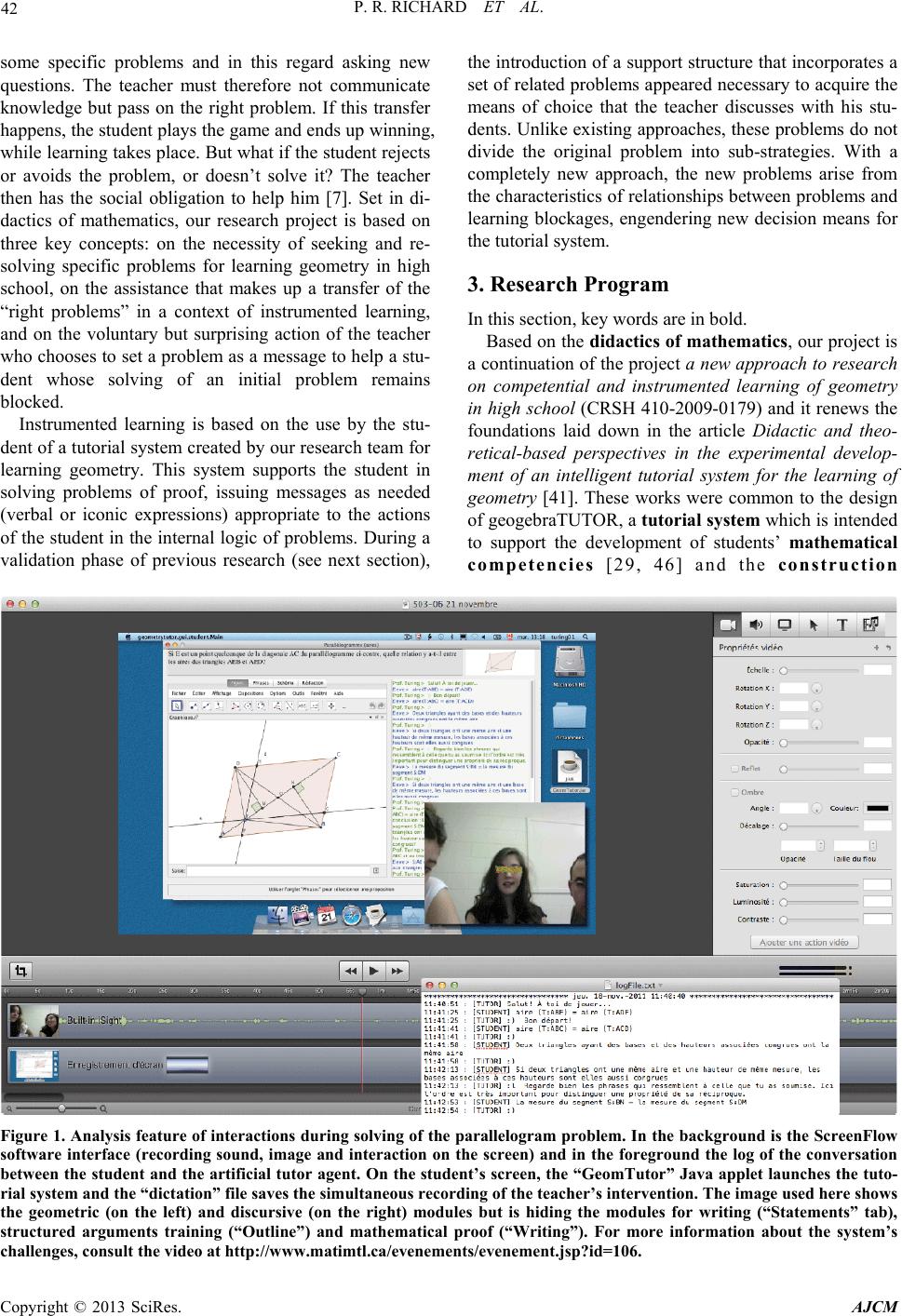 P. R. RICHARD ET AL. 42 some specific problems and in this regard asking new questions. The teacher must therefore not communicate knowledge but pass on the right problem. If this transfer happens, the student plays the game and ends up winning, while learning takes place. But what if the student rejects or avoids the problem, or doesn’t solve it? The teacher then has the social obligation to help him [7]. Set in di- dactics of mathematics, our research project is based on three key concepts: on the necessity of seeking and re- solving specific problems for learning geometry in high school, on the assistance that makes up a transfer of the “right problems” in a context of instrumented learning, and on the voluntary but surprising action of the teacher who chooses to set a problem as a message to help a stu- dent whose solving of an initial problem remains blocked. Instrumented learning is based on the use by the stu- dent of a tutorial system created by our research team for learning geometry. This system supports the student in solving problems of proof, issuing messages as needed (verbal or iconic expressions) appropriate to the actions of the student in the internal logic of problems. During a validation phase of previous research (see next section), the introduction of a support structure that incorporates a set of related problems appeared necessary to acquire the means of choice that the teacher discusses with his stu- dents. Unlike existing approaches, these problems do not divide the original problem into sub-strategies. With a completely new approach, the new problems arise from the characteristics of relationships between problems and learning blockages, engendering new decision means for the tutorial system. 3. Research Program In this section, key words are in bold. Based on the didactics of mathematics, our project is a continuation of the project a new approach to research on competential and instrumented learning of geometry in high school (CRSH 410-2009-0179) and it renews the foundations laid down in the article Didactic and theo- retical-based perspectives in the experimental develop- ment of an intelligent tutorial system for the learning of geometry [41]. These works were common to the design of geogebraTUTOR, a tutorial system which is intended to support the development of students’ mathematical competencies [29, 46] and the construction Figure 1. Analysis feature of interac tions during solving of the parallelogram problem. In the background is the ScreenFlow software interface (recording sound, image and interaction on the screen) and in the foreground the log of the conversation between the student and the artificial tutor agent. On the student’s screen, the “GeomTutor” Java applet launches the tuto- rial system and the “dictation” file saves the simultaneous recording of the teacher’s intervention. The image used here shows the geometric (on the left) and discursive (on the right) modules but is hiding the modules for writing (“Statements” tab), structured arguments training (“Outline”) and mathematical proof (“Writing”). For more information about the system’s challenges, consult the video at http://www.matimtl.ca/evenements/evenement.jsp?id=106. Copyright © 2013 SciRes. AJCM 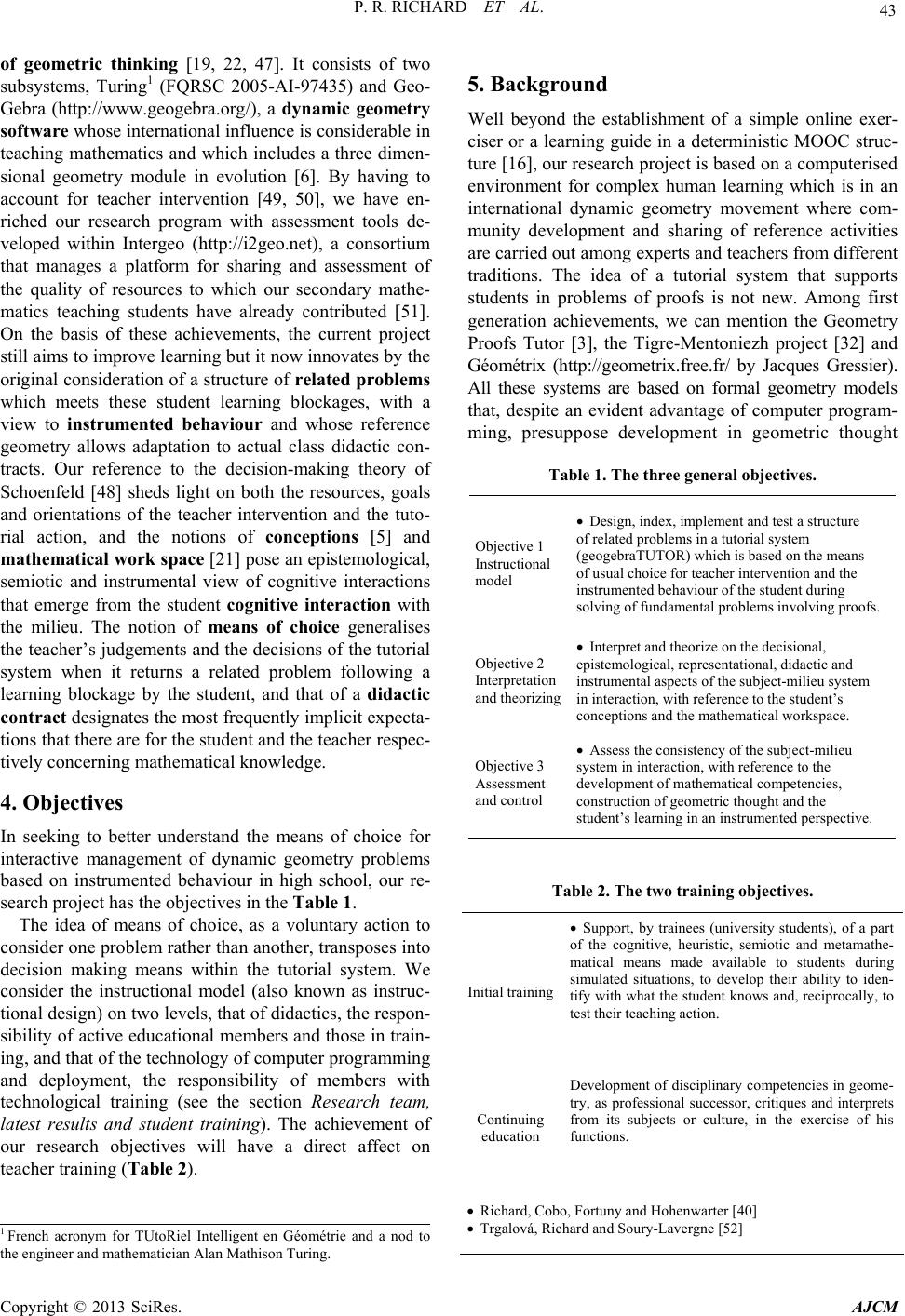 P. R. RICHARD ET AL. 43 of geometric thinking [19, 22, 47]. It consists of two subsystems, Turing1 (FQRSC 2005-AI-97435) and Geo- Gebra (http://www.geogebra.org/), a dynamic geometry software whose international influence is considerable in teaching mathematics and which includes a three dimen- sional geometry module in evolution [6]. By having to account for teacher intervention [49, 50], we have en- riched our research program with assessment tools de- veloped within Intergeo (http://i2geo.net), a consortium that manages a platform for sharing and assessment of the quality of resources to which our secondary mathe- matics teaching students have already contributed [51]. On the basis of these achievements, the current project still aims to improve learning but it now innovates by the original consideration of a structure of related problems which meets these student learning blockages, with a view to instrumented behaviour and whose reference geometry allows adaptation to actual class didactic con- tracts. Our reference to the decision-making theory of Schoenfeld [48] sheds light on both the resources, goals and orientations of the teacher intervention and the tuto- rial action, and the notions of con cept ions [5] and mathematical work space [21] pose an epistemological, semiotic and instrumental view of cognitive interactions that emerge from the student cognitive interaction with the milieu. The notion of means of choice generalises the teacher’s judgements and the decisions of the tutorial system when it returns a related problem following a learning blockage by the student, and that of a didactic contract designates the most frequently implicit expecta- tions that there are for the student and the teacher respec- tively concerning mathematical knowledge. 4. Objectives In seeking to better understand the means of choice for interactive management of dynamic geometry problems based on instrumented behaviour in high school, our re- search project has the objectives in the Table 1. The idea of means of choice, as a voluntary action to consider one problem rather than another, transposes into decision making means within the tutorial system. We consider the instructional model (also known as instruc- tional design) on two levels, that of didactics, the respon- sibility of active educational members and those in train- ing, and that of the technology of computer programming and deployment, the responsibility of members with technological training (see the section Research team, latest results and student training). The achievement of our research objectives will have a direct affect on teacher training (Table 2). 5. Background Well beyond the establishment of a simple online exer- ciser or a learning guide in a deterministic MOOC struc- ture [16], our research project is based on a computerised environment for complex human learning which is in an international dynamic geometry movement where com- munity development and sharing of reference activities are carried out among experts and teachers from different traditions. The idea of a tutorial system that supports students in problems of proofs is not new. Among first generation achievements, we can mention the Geometry Proofs Tutor [3], the Tigre-Mentoniezh project [32] and Géométrix (http://geometrix.free.fr/ by Jacques Gressier). All these systems are based on formal geometry models that, despite an evident advantage of computer program- ming, presuppose development in geometric thought Table 1. The three general objectives. Objective 1 Instructional model Design, index, implement and test a structure of related problems in a tutorial system (geogebraTUTOR) which is based on the means of usual choice for teacher intervention and the instrumented behaviour of the student during solving of fundamental problems involving proofs. Objective 2 Interpretation and theorizing Interpret and theorize on the decisional, epistemological, representational, didactic and instrumental aspects of the subject-milieu system in interaction, with reference to the student’s conceptions and the mathematical workspace. Objective 3 Assessment and control Assess the consistency of the subject-milieu system in interaction, with reference to the development of mathematical competencies, construction of geometric thought and the student’s learning in an instrumented perspective. Table 2. The two training objectives. Initial training Support, by trainees (university students), of a part of the cognitive, heuristic, semiotic and metamathe- matical means made available to students during simulated situations, to develop their ability to iden- tify with what the student knows and, reciprocally, to test their teaching action. Continuing education Development of disciplinary competencies in geome- try, as professional successor, critiques and interprets from its subjects or culture, in the exercise of his functions. Richard, Cobo, Fortuny and Hohenwarter [40] Trgalová, Richard and Soury-Lavergne [52] 1 French acronym for TUtoRiel Intelligent en Géométrie and a nod to the engineer and mathematician Alan Mathison Turing. Copyright © 2013 SciRes. AJCM 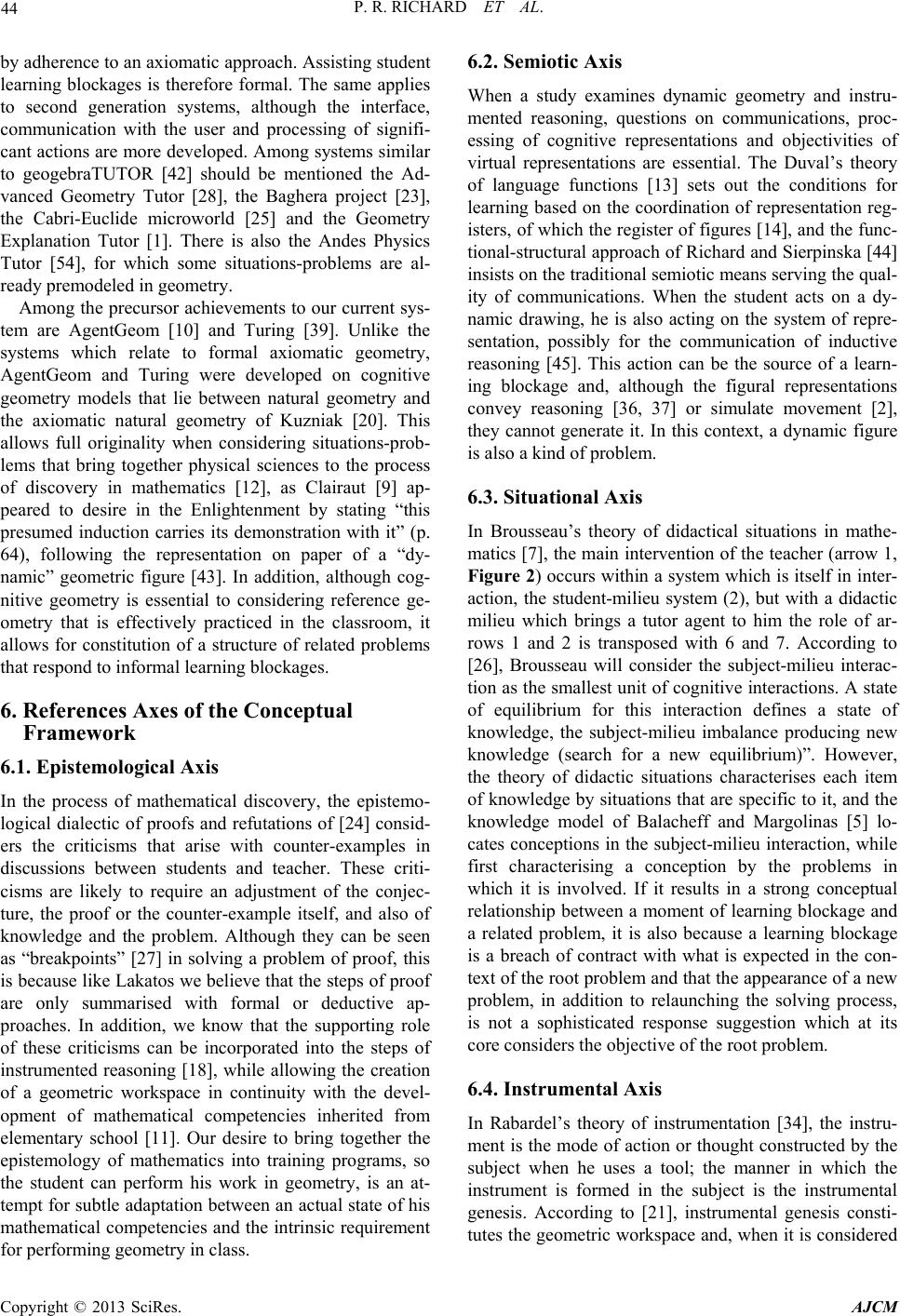 P. R. RICHARD ET AL. 44 by adherence to an axiomatic approach. Assisting student learning blockages is therefore formal. The same applies to second generation systems, although the interface, communication with the user and processing of signifi- cant actions are more developed. Among systems similar to geogebraTUTOR [42] should be mentioned the Ad- vanced Geometry Tutor [28], the Baghera project [23], the Cabri-Euclide microworld [25] and the Geometry Explanation Tutor [1]. There is also the Andes Physics Tutor [54], for which some situations-problems are al- ready premodeled in geometry. Among the precursor achievements to our current sys- tem are AgentGeom [10] and Turing [39]. Unlike the systems which relate to formal axiomatic geometry, AgentGeom and Turing were developed on cognitive geometry models that lie between natural geometry and the axiomatic natural geometry of Kuzniak [20]. This allows full originality when considering situations-prob- lems that bring together physical sciences to the process of discovery in mathematics [12], as Clairaut [9] ap- peared to desire in the Enlightenment by stating “this presumed induction carries its demonstration with it” (p. 64), following the representation on paper of a “dy- namic” geometric figure [43]. In addition, although cog- nitive geometry is essential to considering reference ge- ometry that is effectively practiced in the classroom, it allows for constitution of a structure of related problems that respond to informal learning blockages. 6. References Axes of the Conceptual Framework 6.1. Epistemological Axis In the process of mathematical discovery, the epistemo- logical dialectic of proofs and refutations of [24] consid- ers the criticisms that arise with counter-examples in discussions between students and teacher. These criti- cisms are likely to require an adjustment of the conjec- ture, the proof or the counter-example itself, and also of knowledge and the problem. Although they can be seen as “breakpoints” [27] in solving a problem of proof, this is because like Lakatos we believe that the steps of proof are only summarised with formal or deductive ap- proaches. In addition, we know that the supporting role of these criticisms can be incorporated into the steps of instrumented reasoning [18], while allowing the creation of a geometric workspace in continuity with the devel- opment of mathematical competencies inherited from elementary school [11]. Our desire to bring together the epistemology of mathematics into training programs, so the student can perform his work in geometry, is an at- tempt for subtle adaptation between an actual state of his mathematical competencies and the intrinsic requirement for performing geometry in class. 6.2. Semiotic Axis When a study examines dynamic geometry and instru- mented reasoning, questions on communications, proc- essing of cognitive representations and objectivities of virtual representations are essential. The Duval’s theory of language functions [13] sets out the conditions for learning based on the coordination of representation reg- isters, of which the register of figures [14], and the func- tional-structural approach of Richard and Sierpinska [44] insists on the traditional semiotic means serving the qual- ity of communications. When the student acts on a dy- namic drawing, he is also acting on the system of repre- sentation, possibly for the communication of inductive reasoning [45]. This action can be the source of a learn- ing blockage and, although the figural representations convey reasoning [36, 37] or simulate movement [2], they cannot generate it. In this context, a dynamic figure is also a kind of problem. 6.3. Situational Axis In Brousseau’s theory of didactical situations in mathe- matics [7], the main intervention of the teacher (arrow 1, Figure 2) occurs within a system which is itself in inter- action, the student-milieu system (2), but with a didactic milieu which brings a tutor agent to him the role of ar- rows 1 and 2 is transposed with 6 and 7. According to [26], Brousseau will consider the subject-milieu interac- tion as the smallest unit of cognitive interactions. A state of equilibrium for this interaction defines a state of knowledge, the subject-milieu imbalance producing new knowledge (search for a new equilibrium)”. However, the theory of didactic situations characterises each item of knowledge by situations that are specific to it, and the knowledge model of Balacheff and Margolinas [5] lo- cates conceptions in the subject-milieu interaction, while first characterising a conception by the problems in which it is involved. If it results in a strong conceptual relationship between a moment of learning blockage and a related problem, it is also because a learning blockage is a breach of contract with what is expected in the con- text of the root problem and that the appearance of a new problem, in addition to relaunching the solving process, is not a sophisticated response suggestion which at its core considers the objective of the root problem. 6.4. Instrumental Axis In Rabardel’s theory of instrumentation [34], the instru- ment is the mode of action or thought constructed by the subject when he uses a tool; the manner in which the instrument is formed in the subject is the instrumental genesis. According to [21], instrumental genesis consti- tutes the geometric workspace and, when it is considered Copyright © 2013 SciRes. AJCM  P. R. RICHARD ET AL. Copyright © 2013 SciRes. AJCM 45 in the process of student-milieu interaction which creates its own space, instrumental genesis operates both during stages of discovery and validation [11]. Since the proc- esses of instrumentation relate to the emergence and de- velopment of patterns of use and instrumented action, the progressive discovery of the tool’s intrinsic properties by students, for whom the appearance of a related problem following a learning blockage is accompanied by the accommodation of their patterns and also changes in meaning of the instrument, results in association of the tool with new patterns [35]. The notions of conception and instrument occupy dual places in modelling of the subject-milieu [5]. 6.5. Decisional Axis The transposition of the teacher’s intervention in the educational environment is necessarily accompanied by a transposition of means of the choice. Although these means can be interpreted in respect of a didactic contract, the implicitly shared significance that it supposes com- plicates understanding of the decisional process in all of the fundamental relationships. According to [7], the di- dactic contract is not really a true contract, since it is not explicit or voluntary and because neither the conditions for breach nor sanctions can be given in advance due to their didactic nature, which depends significantly on a knowledge of students that is as yet unknown. In Schoenfeld’s decision making theory [48], if we know enough about what someone’s resources, goals and ori- entations are, teacher or student, we can even come to understand, explain and model actions and decisions that seem unusual or abnormal. In the Introduction paragraph, the illustration of the sudden appearance of a new request for solving problem, while it was the first solving proc- essed that was blocked, may surprise the observer but not the students, who are used to reacting to this type of requirement from their teacher. 7. Methodology 7.1. General Direction As with our previous projects, we take advantage of a similar experimental effort to “verify a state or a change” and “develop accordingly”. In fact, the illustration in the Foreword comes from an experiment (see the link below Figure 1 and [50] which allowed, firstly, verification of the validity of a structure of messages from the tutor agent when two classes of high school students resolved problems of proof and, secondly, identification of the means of choice of their teachers with the use of related problems after indexation of conceptual, heuristic, semi- otic and met mathematical criteria [42]. This requirement invites us to consider together two paradigms on the epistemological didactic level. On the conceptual side, the learning models that we claim identify with the use of our tutorial system based on the preceding axes. On the methodological side, the approach implemented com- bines the didactic engineering of Artigue [4] and the grounded theory analysis of Glaser and Strauss [17]. Since the functional integration of a structure of related problems in the instructional model is in line with our project (see Acknowledgements), we can achieve objec- tives 1 and 3 with a confirmatory model [53] of the hy- pothesis-deduction type [4]. But the intervention of these problems depends on the instrumented behaviour, and since they generate a non-deterministic learning itinerary (following related problems), the emergence of learning models adapted to the use of an advanced tutorial system commits us to achieving objective 2 using a compara- tive-inductive type model [17]. Figure 2. Fundame ntal relationships in the rese arc h syste m. It is an adaptation of [7] on the r elationship of 1 to 4 between th e teacher, the student and the milie u [41]. 7.2. Description of Key Activities and Specific Procedures Here is a brief description of phases of the research in relation to the objectives, for trimester Q. Phase 1 (Q1-2) ↓ Conception of the instructional model– preparation of objective 1 (1st part) • From the 34 problems based on [33] and adaptation  P. R. RICHARD ET AL. 46 of these to the curriculum in effect in the regions of the participating researchers, characterisation of problems according to the identity of problems [38] and indexation of them according to the above criteria. • Implementation in geogebraTUTOR of a structure of related problems and testing experts on the functioning of the didactic milieu according to the learning model of [41]. Phase 2 (Q3-4) ↓ 1 st experiment in the schools – achievement of objective 1 (1st part) To validate by cross-referencing primitive sources – or “triangulation” [15]: • Collection of student-milieu interactions and teacher interventions in 3 classes of second cycle of high school in three different regions when, in their normal courses, students solve five problems of proof using the system interface (qualitative data, [30]). • Request to teachers to reconstruct their interventions and compare the means of choice of the tutorial system with the didactic contract of the course [31, 8] during 50 minute explanatory discussions [55]. In addition to the log files, there will be “ScreenFlow” records (see Figure 1) for a sample of 24 volunteer stu- dents (4 teams of 2 per class), as well as audio recordings for the teachers of each class (intervention in class and explanatory discussions), in accordance with the ethical rules in force – ditto for entering and processing data in all phases. Phase 3 (Q5-6) ↓ Analysis and interpretation – prepara- tion of objectives 2 and 3 (1st part) • Analysis of times of learning blockage – or break- points – according to the knowledge model of Balacheff and Margolinas [5] by characterising conceptions C by a defining set of problems (P) for which solving tools (R) are provided based on representation systems (L) and a control structure (Σ) which permits judgements and deci- sions. • Interpretation of times of learning blockage by join- ing the student’s conceptions C = (P, R, L, Σ) with the characteristics of the related problems in play (of the system, phase 1; of teachers, phase 2). Phase 4 (Q7-8) ↓ Cross-referencing, validation and fine-tuning – preparation for objective 1 (2nd part) and achievement of objective 2 (1st part) • Pooling of the results of phase 3 between researchers and identification of patterns. • To improve the instructional model and better under- stand the common or invariant characteristics of the sub- ject-milieu system in interaction, expert validation of the combination of phase 3. • Optimisation of the articulation and continuity be- tween the conception of the tutorial system and pursuit of the conception during solving by the students (or “con- ception in use”, [34]). Phase 5 (Q9-10) ↓ 2 nd experiment in the schools – preparation of objective 3 (2nd part) and achievement of objective 1 (2nd part) • Resumption of the procedures for phase 2, by this time asking teachers to assess the solutions (without not- ing them) with a view to assessing competencies [38]. Phase 6 (Q11-12) ↓ Modelling, synthesis, theorisation – achievement of objectives 2 (2nd part) and 3 • Modelling of an ontology on the basis of didactic contracts and instrumented behaviour. • Summary of the non-deterministic learning itineraries and underlying means of choice. • Theorisation on the fundamental relationships of the instrumented didactic situation (Figure 2). 8. Knowledge Mobilisation Plan As a human sciences discipline, the teaching of mathe- matics has a scientific side and a professional side, in- cluding the initial and continuing training of teachers in the field. When a project involves not only teaching theories but also construction of computer environments for human learning, questions arise in a very practical way, which leads to seeking a functional modelling of knowledge by making distinctions that are useful feed- back for the teaching of mathematics as a whole. Our plan for knowledge mobilisation, similar to that which is grounded in our research program, aims to continue the multidirectional exchange of knowledge between re- searchers, teachers and other persons involved in the world of teaching mathematics, in a collaborative spirit of sharing which includes quality, integration and popu- larisation. We can summarise the overall mobilisation plan in terms of places2: • Publication in journals for the quality of the research (ESM, IJCML, ZDM, etc.), its integration (ADSC, REC, PME, etc.) and its popularisation (AMQ, PME, UNO, etc.); • Organisation and participation in international sym- posia on teaching mathematics (EMF, ETM, CERME, etc.) as well as mathematics classroom technologies (INTERGEO, CADGME, E-LEARN, etc.); • Initial and continuing training sessions for teachers (UDM, UAB, GRMS, etc.); • Participation as appropriate in advisory bodies on training or technology programs (UDM, CCPÉ, MATI, etc.). and of means, thanks to advanced technological skilled of team members: • Community and sharing development platform for research quality (Turing, cK¢ wikibook, etc.), its integra- tion (I2GÉO, NTLMP, etc.) and its popularisation 2We list acronyms and websites in the section References. Copyright © 2013 SciRes. AJCM 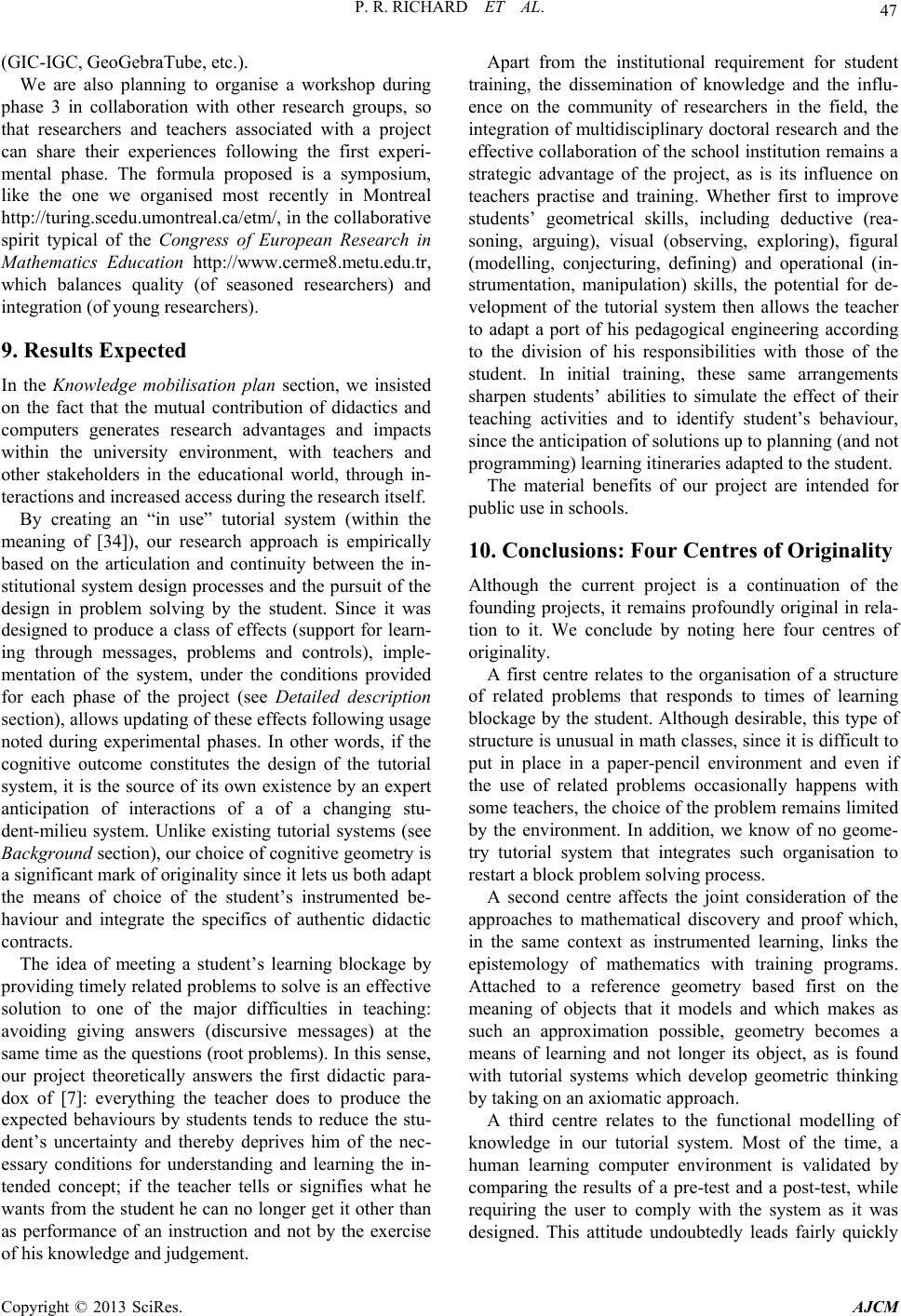 P. R. RICHARD ET AL. 47 (GIC-IGC, GeoGebraTube, etc.). We are also planning to organise a workshop during phase 3 in collaboration with other research groups, so that researchers and teachers associated with a project can share their experiences following the first experi- mental phase. The formula proposed is a symposium, like the one we organised most recently in Montreal http://turing.scedu.umontreal.ca/etm/, in the collaborative spirit typical of the Congress of European Research in Mathematics Education http://www.cerme8.metu.edu.tr, which balances quality (of seasoned researchers) and integration (of young researchers). 9. Results Expected In the Knowledge mobilisation plan section, we insisted on the fact that the mutual contribution of didactics and computers generates research advantages and impacts within the university environment, with teachers and other stakeholders in the educational world, through in- teractions and increased access during the research itself. By creating an “in use” tutorial system (within the meaning of [34]), our research approach is empirically based on the articulation and continuity between the in- stitutional system design processes and the pursuit of the design in problem solving by the student. Since it was designed to produce a class of effects (support for learn- ing through messages, problems and controls), imple- mentation of the system, under the conditions provided for each phase of the project (see Detailed description section), allows updating of these effects following usage noted during experimental phases. In other words, if the cognitive outcome constitutes the design of the tutorial system, it is the source of its own existence by an expert anticipation of interactions of a of a changing stu- dent-milieu system. Unlike existing tutorial systems (see Background section), our choice of cognitive geometry is a significant mark of originality since it lets us both adapt the means of choice of the student’s instrumented be- haviour and integrate the specifics of authentic didactic contracts. The idea of meeting a student’s learning blockage by providing timely related problems to solve is an effective solution to one of the major difficulties in teaching: avoiding giving answers (discursive messages) at the same time as the questions (root problems). In this sense, our project theoretically answers the first didactic para- dox of [7]: everything the teacher does to produce the expected behaviours by students tends to reduce the stu- dent’s uncertainty and thereby deprives him of the nec- essary conditions for understanding and learning the in- tended concept; if the teacher tells or signifies what he wants from the student he can no longer get it other than as performance of an instruction and not by the exercise of his knowledge and judgement. Apart from the institutional requirement for student training, the dissemination of knowledge and the influ- ence on the community of researchers in the field, the integration of multidisciplinary doctoral research and the effective collaboration of the school institution remains a strategic advantage of the project, as is its influence on teachers practise and training. Whether first to improve students’ geometrical skills, including deductive (rea- soning, arguing), visual (observing, exploring), figural (modelling, conjecturing, defining) and operational (in- strumentation, manipulation) skills, the potential for de- velopment of the tutorial system then allows the teacher to adapt a port of his pedagogical engineering according to the division of his responsibilities with those of the student. In initial training, these same arrangements sharpen students’ abilities to simulate the effect of their teaching activities and to identify student’s behaviour, since the anticipation of solutions up to planning (and not programming) learning itineraries adapted to the student. The material benefits of our project are intended for public use in schools. 10. Conclusions: Four Centres of Originality Although the current project is a continuation of the founding projects, it remains profoundly original in rela- tion to it. We conclude by noting here four centres of originality. A first centre relates to the organisation of a structure of related problems that responds to times of learning blockage by the student. Although desirable, this type of structure is unusual in math classes, since it is difficult to put in place in a paper-pencil environment and even if the use of related problems occasionally happens with some teachers, the choice of the problem remains limited by the environment. In addition, we know of no geome- try tutorial system that integrates such organisation to restart a block problem solving process. A second centre affects the joint consideration of the approaches to mathematical discovery and proof which, in the same context as instrumented learning, links the epistemology of mathematics with training programs. Attached to a reference geometry based first on the meaning of objects that it models and which makes as such an approximation possible, geometry becomes a means of learning and not longer its object, as is found with tutorial systems which develop geometric thinking by taking on an axiomatic approach. A third centre relates to the functional modelling of knowledge in our tutorial system. Most of the time, a human learning computer environment is validated by comparing the results of a pre-test and a post-test, while requiring the user to comply with the system as it was designed. This attitude undoubtedly leads fairly quickly Copyright © 2013 SciRes. AJCM 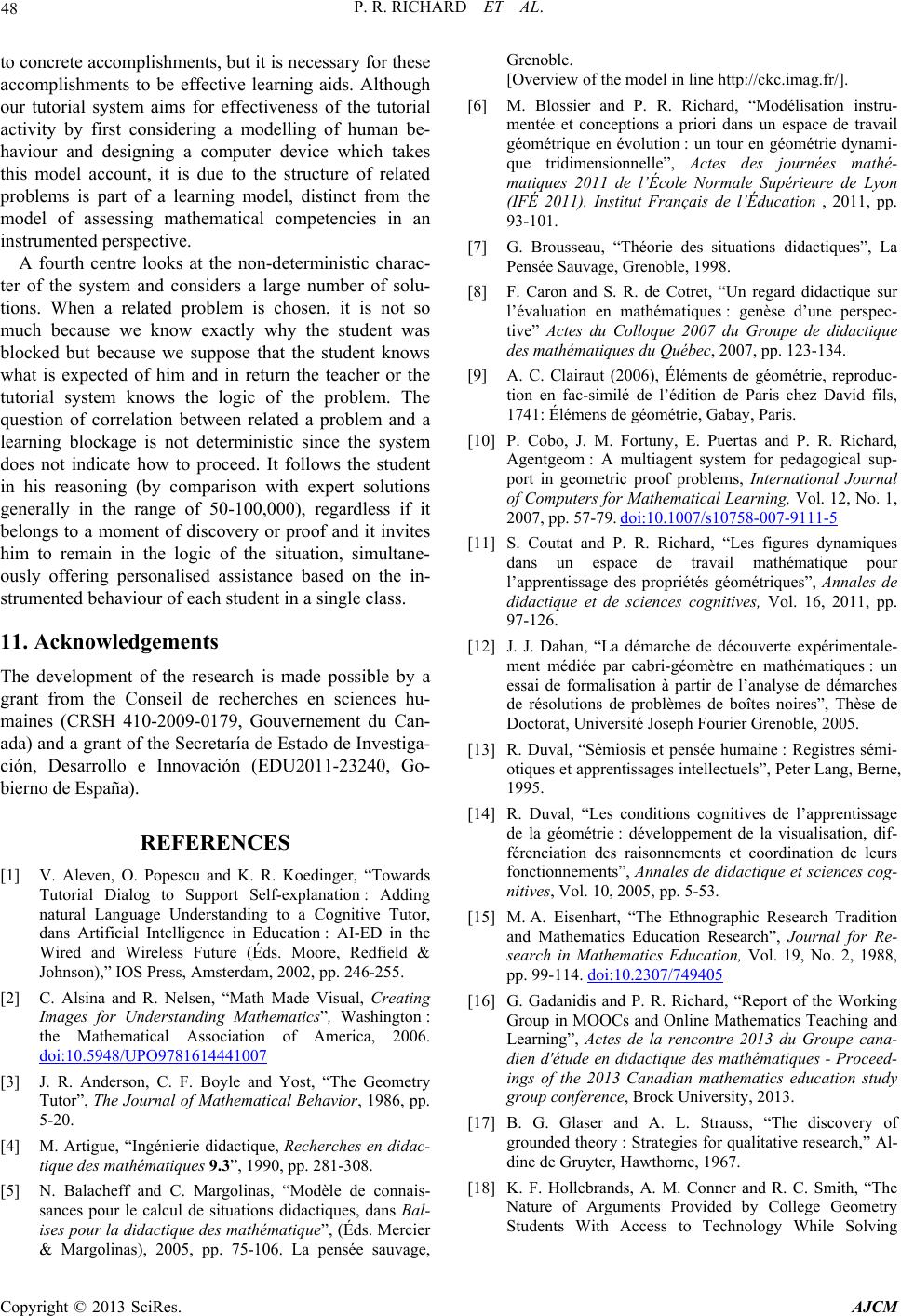 P. R. RICHARD ET AL. 48 to concrete accomplishments, but it is necessary for these accomplishments to be effective learning aids. Although our tutorial system aims for effectiveness of the tutorial activity by first considering a modelling of human be- haviour and designing a computer device which takes this model account, it is due to the structure of related problems is part of a learning model, distinct from the model of assessing mathematical competencies in an instrumented perspective. A fourth centre looks at the non-deterministic charac- ter of the system and considers a large number of solu- tions. When a related problem is chosen, it is not so much because we know exactly why the student was blocked but because we suppose that the student knows what is expected of him and in return the teacher or the tutorial system knows the logic of the problem. The question of correlation between related a problem and a learning blockage is not deterministic since the system does not indicate how to proceed. It follows the student in his reasoning (by comparison with expert solutions generally in the range of 50-100,000), regardless if it belongs to a moment of discovery or proof and it invites him to remain in the logic of the situation, simultane- ously offering personalised assistance based on the in- strumented behaviour of each student in a single class. 11. Acknowledgements The development of the research is made possible by a grant from the Conseil de recherches en sciences hu- maines (CRSH 410-2009-0179, Gouvernement du Can- ada) and a grant of the Secretaría de Estado de Investiga- ción, Desarrollo e Innovación (EDU2011-23240, Go- bierno de España). REFERENCES [1] V. Aleven, O. Popescu and K. R. Koedinger, “Towards Tutorial Dialog to Support Self-explanation : Adding natural Language Understanding to a Cognitive Tutor, dans Artificial Intelligence in Education : AI-ED in the Wired and Wireless Future (Éds. Moore, Redfield & Johnson),” IOS Press, Amsterdam, 2002, pp. 246-255. [2] C. Alsina and R. Nelsen, “Math Made Visual, Creating Images for Understanding Mathematics”, Washington : the Mathematical Association of America, 2006. doi:10.5948/UPO9781614441007 [3] J. R. Anderson, C. F. Boyle and Yost, “The Geometry Tutor”, The Journal of Mathematical Behavior, 1986, pp. 5-20. [4] M. Artigue, “Ingénierie didactique, Recherches en didac- tique des mathématiques 9.3”, 1990, pp. 281-308. [5] N. Balacheff and C. Margolinas, “Modèle de connais- sances pour le calcul de situations didactiques, dans Bal- ises pour la didactique des mathématique”, (Éds. Mercier & Margolinas), 2005, pp. 75-106. La pensée sauvage, Grenoble. [Overview of the model in line http://ckc.imag.fr/]. [6] M. Blossier and P. R. Richard, “Modélisation instru- mentée et conceptions a priori dans un espace de travail géométrique en évolution : un tour en géométrie dynami- que tridimensionnelle”, Actes des journées mathé- matiques 2011 de l’École Normale Supérieure de Lyon (IFÉ 2011), Institut Français de l’Éducation , 2011, pp. 93-101. [7] G. Brousseau, “Théorie des situations didactiques”, La Pensée Sauvage, Grenoble, 1998. [8] F. Caron and S. R. de Cotret, “Un regard didactique sur l’évaluation en mathématiques : genèse d’une perspec- tive” Actes du Colloque 2007 du Groupe de didactique des mathématiques du Québec, 2007, pp. 123-134. [9] A. C. Clairaut (2006), Éléments de géométrie, reproduc- tion en fac-similé de l’édition de Paris chez David fils, 1741: Élémens de géométrie, Gabay, Paris. [10] P. Cobo, J. M. Fortuny, E. Puertas and P. R. Richard, Agentgeom : A multiagent system for pedagogical sup- port in geometric proof problems, International Journal of Computers for Mathematical Learning, Vol. 12, No. 1, 2007, pp. 57-79. doi:10.1007/s10758-007-9111-5 [11] S. Coutat and P. R. Richard, “Les figures dynamiques dans un espace de travail mathématique pour l’apprentissage des propriétés géométriques”, Annales de didactique et de sciences cognitives, Vol. 16, 2011, pp. 97-126. [12] J. J. Dahan, “La démarche de découverte expérimentale- ment médiée par cabri-géomètre en mathématiques : un essai de formalisation à partir de l’analyse de démarches de résolutions de problèmes de boîtes noires”, Thèse de Doctorat, Université Joseph Fourier Grenoble, 2005. [13] R. Duval, “Sémiosis et pensée humaine : Registres sémi- otiques et apprentissages intellectuels”, Peter Lang, Berne, 1995. [14] R. Duval, “Les conditions cognitives de l’apprentissage de la géométrie : développement de la visualisation, dif- férenciation des raisonnements et coordination de leurs fonctionnements”, Annales de didactique et sciences cog- nitives, Vol. 10, 2005, pp. 5-53. [15] M. A. Eisenhart, “The Ethnographic Research Tradition and Mathematics Education Research”, Journal for Re- search in Mathematics Education, Vol. 19, No. 2, 1988, pp. 99-114. doi:10.2307/749405 [16] G. Gadanidis and P. R. Richard, “Report of the Working Group in MOOCs and Online Mathematics Teaching and Learning”, Actes de la rencontre 2013 du Groupe cana- dien d'étude en didactique des mathématiques - Proceed- ings of the 2013 Canadian mathematics education study group conference, Brock University, 2013. [17] B. G. Glaser and A. L. Strauss, “The discovery of grounded theory : Strategies for qualitative research,” Al- dine de Gruyter, Hawthorne, 1967. [18] K. F. Hollebrands, A. M. Conner and R. C. Smith, “The Nature of Arguments Provided by College Geometry Students With Access to Technology While Solving Copyright © 2013 SciRes. AJCM  P. R. RICHARD ET AL. 49 Problems”, Journal for Research in Mathematics Educa- tion, Vol. 41, No. 4, 2010, pp. 324-350. [19] S. Johnston-Wilder and J. Mason, “Developing Thinking in Geometry”, The Open University, 2005. [20] A. Kuzniak, “Paradigmes et espaces de travail géométri- ques. Éléments d’un cadre théorique pour l’enseignement et la formation des enseignants en géométrie”, Revue ca- nadienne de l’enseignement des sciences, des mathé- matiques et des technologies, Vol. 6, No. 2, 2006, pp. 167-187. [21] A. Kuzniak, “L’espace de travail mathématique et ses genèses”, Annales de didactique et de sciences cognitives Vol. 16, 2011, pp. 9-24. [22] A. Kuzniak, P. R. Richard and A. Gagatsis, “CERME7 Working Group 4 : Geometry teaching and learning”, Research in Mathematics Education, Vol. 14, No. 2, 2012, pp. 191-192. doi:10.1080/14794802.2012.694285 [23] Laboratoire Leibniz, “Baghera assessment project : De- signing an hybrid and emergent educational society”, dans Rapport pour la commission européenne, Pro- gramme IST, Les Cahiers du Laboratoire Leibniz nº 81 (Éd. Soury-Lavergne). Grenoble, 2003. [24] I. Lakatos, Preuves et réfutations. Essai sur la logique de la découverte mathématique. Hermann, Paris, 1984. [25] V. Luengo, Some didactical and epistemological consid- erations in the design of educational software : The cabri-euclide example, International Journal of Com- puters for Mathematical Learning, Vol. 10, No. 1, 2005, pp. 1-29. doi.org/10.1007/s10758-005-4580-x [26] C. Margolinas, Points de vue de l’élève et du professeur : essai de développement de la théorie des situations didac- tiques, Habilitation à diriger les recherches en sciences de l’éducation, Université de Provence, version électronique récupérée le 26 juillet 2010 à http://tel.archivesouvertes.fr/docs/00/42/96/95/PDF/HDR _Margolinas.pdf. [27] J. Mason, Researching Your Own Practice : The Disci- pline of Noticing. Londres et New York : Routledge, 2005. [28] N. Matsuda and K. VanLehn, “Advanced geometry tutor : An intelligent tutor that teaches proof-writing with con- struction”, dans The 12th International Conference on Artificial Intelligence in Education (Éds. Looi, McCalla, Bredeweg & Breuker), 2005, pp. 443-450. IOS Press, Amsterdam. [29] MÉLS (2001, 2006 et 2007), Programme de formation de l’école québécoise, éducation préscolaire, enseignement primaire (2001), enseignement secondaire 1er cycle (2006) et enseignement secondaire 2e cycle (2007). Publications du Gouvernement du Québec. [30] P. Paillé and A. Mucchielli, “L’analyse qualitative en sciences humaines et sociales”, Paris : Armand Colin, 2008. [31] M. J. Perrin-Glorian and Y. Reuter, “Les méthodes de recherche en didactiques”, Villeneuve d’Ascq, France : Presses Universitaires du Septentrion, 2006. [32] D. Py, Aide à la démonstration en géométrie : le projet Mentoniezh, Sciences et Techniques Educatives, Vol. 3, No .2, 1996, pp. 227-256. [33] D. Py, “Environnements interactifs d’apprentissage et démonstration en géométrie”, Habilitation à diriger des recherches, Université de Rennes, 2001. [34] P. Rabardel, “Les hommes et les technologies : Approche cognitive des instruments contemporains”, Armand Colin, Paris, 1995. [35] P. Rabardel and Pastré, “Modèles du sujet pour la con- ception : dialectiques activités développement”, Tou- louse : Octarès, 2005. [36] P. R. Richard, “Raisonnement et stratégies de preuve dans l’enseignement des mathématiques”, Peter Lang, Berne, 2004a. [37] P. R. Richard, “L’inférence figurale : Un pas de raison- nement discursivo-graphique”, Educational Studies in Mathematics, Vol. 57, No. 2, 2004b, pp. 229-263. doi:10.1023/B:EDUC.0000049272.75852.c4 [38] P. R. Richard (2010a et b), “La geometría dinámica como herramienta para desarrollar competencias de modeli- zación en el Bachillerato” (2010a), “La evaluación de competencias matemáticas : una apuesta de aprendizaje desde la elección de situaciones-problemas” (2010b), dans Competencias matemáticas. Instrumentos para las ciencias sociales y naturales (Éd. Chacón) 21-57 et 59-81. Publicaciones del Ministerio de Educación, Gobierno de España. [39] P. R. Richard and J. M. Fortuny, “Amélioration des com- pétences argumentatives à l’aide d’un système tutoriel en classe de mathématique au secondaire”, Annales de di- dactique et de sciences cognitives, Vol. 12, 2007, pp. 83-116. [40] P. R. Richard, P. Cobo, J. M. Fortuny, M. Hohenwarter, “Training teachers to manage problem-solving classes with computer support”, Journal of Applied Computing, Vol. 5, No. 1, 2009, pp. 38-50. [41] P. R. Richard, J. M. Fortuny, M. Gagnon, N. Leduc, E. Puertas and M. Tessier- Baillargeon, “Didactic and theo- retical-based perspectives in the experimental develop- ment of an intelligent tutorial system for the learning of geometry, dans Interoperable interactive geometry for Europe (Éds. Kortenkamp & Laborde)”, ZDM - The In- ternational Journal on Mathematics Education, Vol. 43, 2011, pp. 425-439. [42] P. R. Richard, J. M. Fortuny, M. Hohenwarter and M. Gagnon, “geogebraTUTOR : une nouvelle approche pour la recherche sur l’apprentissage compétentiel et instru- menté de la géométrie à l’école secondaire”, Actes de la World Conference on E-Learning in Corporate, Govern- ment, Healthcare, and Higher Education, 2007. [43] P. R. Richard, V. Meavilla and J. M. Fortuny, “Textos clásicos y geometría dinámica : estudio de un aporte mu- tuo para el aprendizaje de la geometría”, Revista En- señanza de las Ciencias, Vol. 28, No. 1, 2010, pp. 95-111. [44] P. R. Richard and A. Sierpinska, “Étude fonction- nelle-structurelle de deux extraits de manuels anciens de Copyright © 2013 SciRes. AJCM 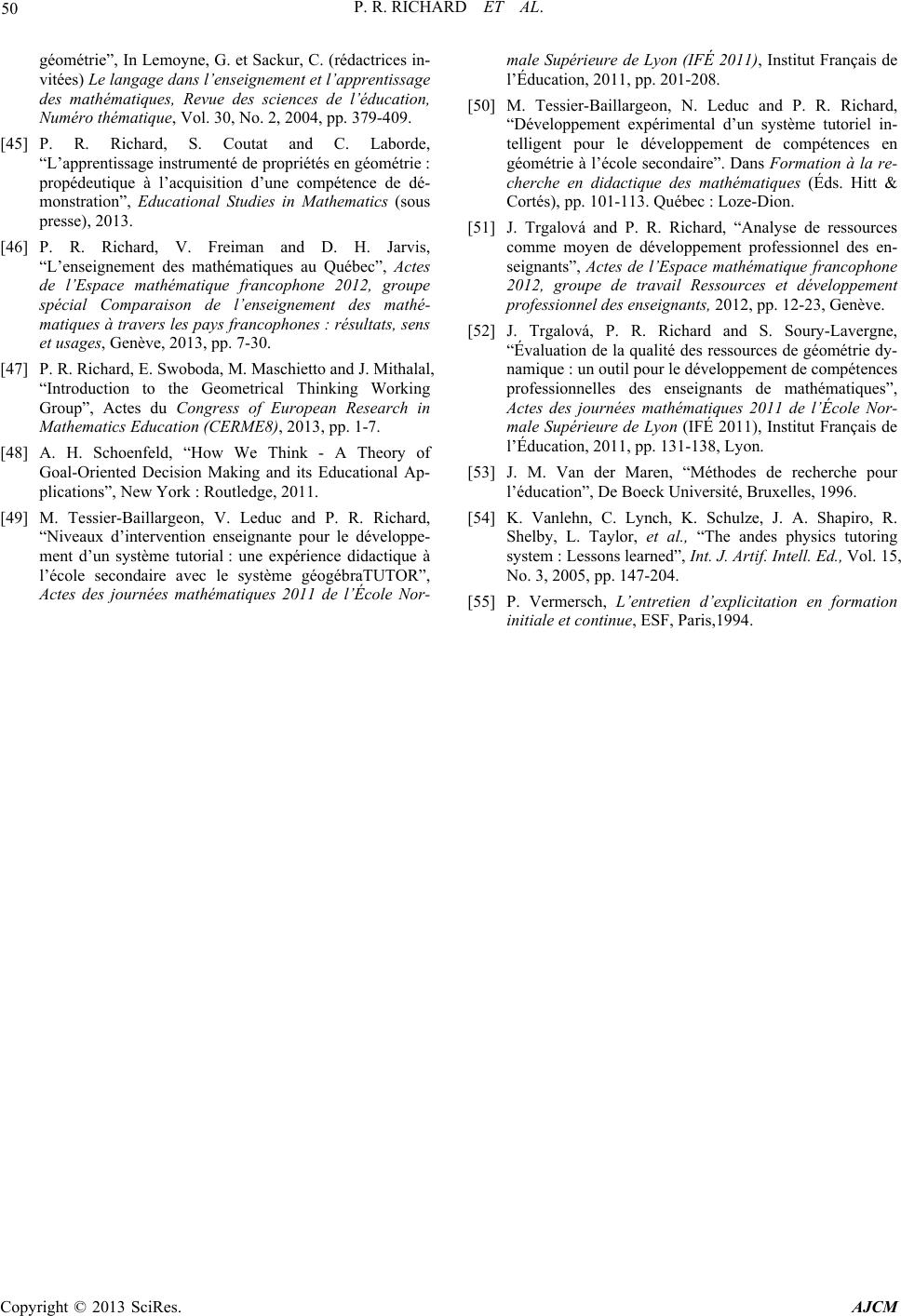 P. R. RICHARD ET AL. Copyright © 2013 SciRes. AJCM 50 géométrie”, In Lemoyne, G. et Sackur, C. (rédactrices in- vitées) Le langage dans l’enseignement et l’apprentissage des mathématiques, Revue des sciences de l’éducation, Numéro thématique, Vol. 30, No. 2, 2004, pp. 379-409. [45] P. R. Richard, S. Coutat and C. Laborde, “L’apprentissage instrumenté de propriétés en géométrie : propédeutique à l’acquisition d’une compétence de dé- monstration”, Educational Studies in Mathematics (sous presse), 2013. [46] P. R. Richard, V. Freiman and D. H. Jarvis, “L’enseignement des mathématiques au Québec”, Actes de l’Espace mathématique francophone 2012, groupe spécial Comparaison de l’enseignement des mathé- matiques à travers les pays francophones : résultats, sens et usages, Genève, 2013, pp. 7-30. [47] P. R. Richard, E. Swoboda, M. Maschietto and J. Mithalal, “Introduction to the Geometrical Thinking Working Group”, Actes du Congress of European Research in Mathematics Education (CERME8), 2013, pp. 1-7. [48] A. H. Schoenfeld, “How We Think - A Theory of Goal-Oriented Decision Making and its Educational Ap- plications”, New York : Routledge, 2011. [49] M. Tessier-Baillargeon, V. Leduc and P. R. Richard, “Niveaux d’intervention enseignante pour le développe- ment d’un système tutorial : une expérience didactique à l’école secondaire avec le système géogébraTUTOR”, Actes des journées mathématiques 2011 de l’École Nor- male Supérieure de Lyon (IFÉ 2011), Institut Français de l’Éducation, 2011, pp. 201-208. [50] M. Tessier-Baillargeon, N. Leduc and P. R. Richard, “Développement expérimental d’un système tutoriel in- telligent pour le développement de compétences en géométrie à l’école secondaire”. Dans Formation à la re- cherche en didactique des mathématiques (Éds. Hitt & Cortés), pp. 101-113. Québec : Loze-Dion. [51] J. Trgalová and P. R. Richard, “Analyse de ressources comme moyen de développement professionnel des en- seignants”, Actes de l’Espace mathématique francophone 2012, groupe de travail Ressources et développement professionnel des enseignants, 2012, pp. 12-23, Genève. [52] J. Trgalová, P. R. Richard and S. Soury-Lavergne, “Évaluation de la qualité des ressources de géométrie dy- namique : un outil pour le développement de compétences professionnelles des enseignants de mathématiques”, Actes des journées mathématiques 2011 de l’École Nor- male Supérieure de Lyon (IFÉ 2011), Institut Français de l’Éducation, 2011, pp. 131-138, Lyon. [53] J. M. Van der Maren, “Méthodes de recherche pour l’éducation”, De Boeck Université, Bruxelles, 1996. [54] K. Vanlehn, C. Lynch, K. Schulze, J. A. Shapiro, R. Shelby, L. Taylor, et al., “The andes physics tutoring system : Lessons learned”, Int. J. Artif. Intell. Ed., Vol. 15, No. 3, 2005, pp. 147-204. [55] P. Vermersch, L’entretien d’explicitation en formation initiale et continue, ESF, Paris,1994. 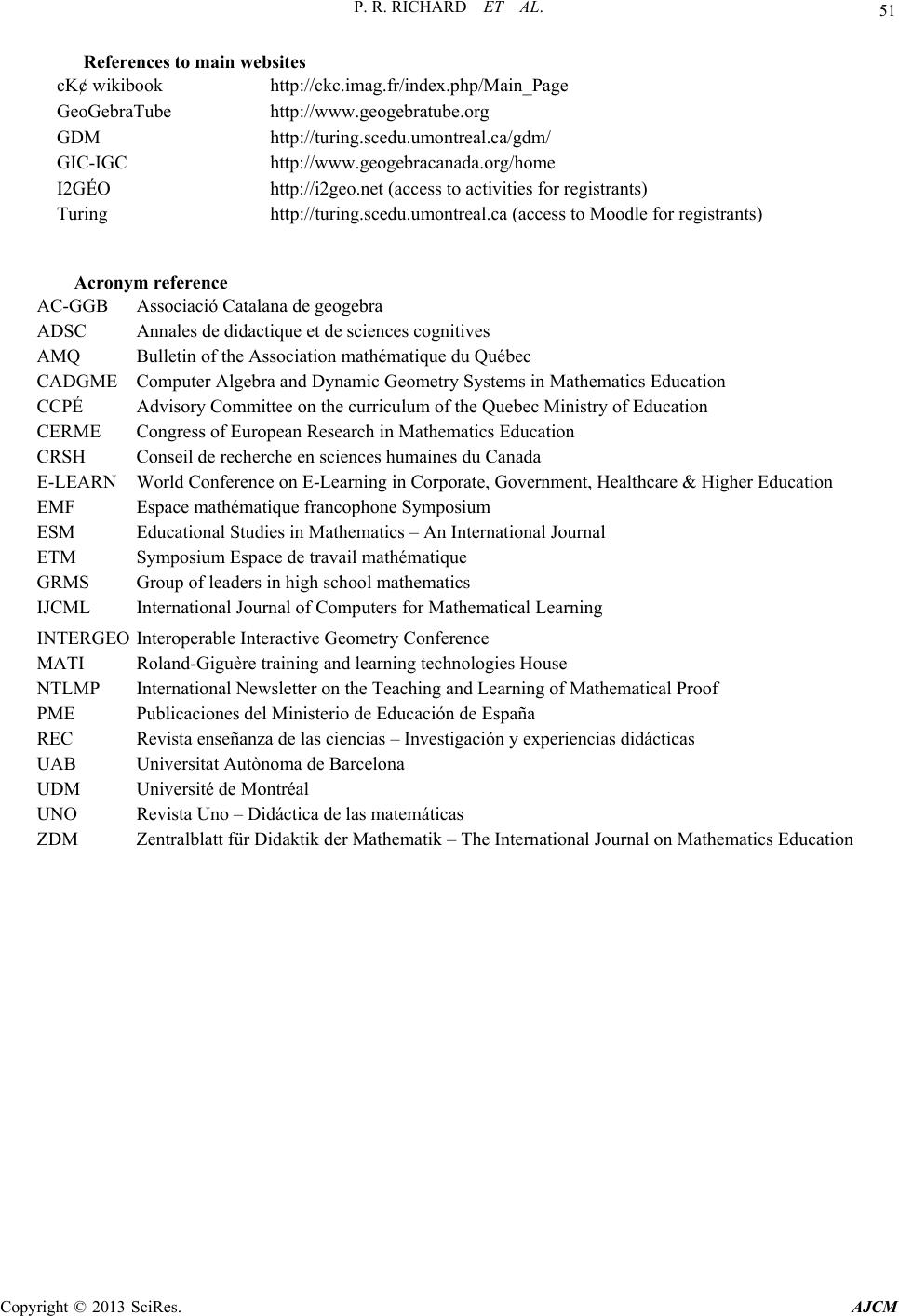 P. R. RICHARD ET AL. 51 References to main websites cK¢ wikibook http://ckc.imag.fr/index.php/Main_Page GeoGebraTube http://www.geogebratube.org GDM http://turing.scedu.umontreal.ca/gdm/ GIC-IGC http://www.geogebracanada.org/home I2GÉO http://i2geo.net (access to activities for registrants) Turing http://turing.scedu.umontreal.ca (access to Moodle for registrants) Acronym reference AC-GGB Associació Catalana de geogebra ADSC Annales de didactique et de sciences cognitives AMQ Bulletin of the Association mathématique du Québec CADGME Computer Algebra and Dynamic Geometry Systems in Mathematics Education CCPÉ Advisory Committee on the curriculum of the Quebec Ministry of Education CERME Congress of European Research in Mathematics Education CRSH Conseil de recherche en sciences humaines du Canada E-LEARN World Conference on E-Learning in Corporate, Government, Healthcare & Higher Education EMF Espace mathématique francophone Symposium ESM Educational Studies in Mathematics – An International Journal ETM Symposium Espace de travail mathématique GRMS Group of leaders in high school mathematics IJCML International Journal of Computers for Mathematical Learning INTERGEO Interoperable Interactive Geometry Conference MATI Roland-Giguère training and learning technologies House NTLMP International Newsletter on the Teaching and Learning of Mathematical Proof PME Publicaciones del Ministerio de Educación de España REC Revista enseñanza de las ciencias – Investigación y experiencias didácticas UAB Universitat Autònoma de Barcelona UDM Université de Montréal UNO Revista Uno – Didáctica de las matemáticas ZDM Zentralblatt für Didaktik der Mathematik – The International Journal on Mathematics Education Copyright © 2013 SciRes. AJCM
|